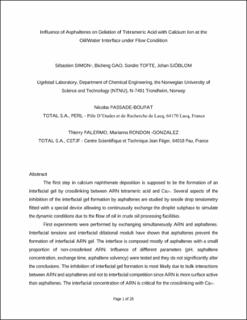| dc.contributor.author | Simon, Sebastien Charles | |
| dc.contributor.author | Gao, Bicheng | |
| dc.contributor.author | Tofte, Sondre | |
| dc.contributor.author | Sjøblom, Johan | |
| dc.contributor.author | Passade-Boupat, Nicolas | |
| dc.contributor.author | Palermo, Thierry | |
| dc.contributor.author | Rondon-Gonzalez, Marianna | |
| dc.date.accessioned | 2020-05-13T12:03:29Z | |
| dc.date.available | 2020-05-13T12:03:29Z | |
| dc.date.created | 2020-05-12T16:23:39Z | |
| dc.date.issued | 2020 | |
| dc.identifier.issn | 0887-0624 | |
| dc.identifier.uri | https://hdl.handle.net/11250/2654255 | |
| dc.description.abstract | The first step in calcium naphthenate deposition is supposed to be the formation of an interfacial gel by cross-linking between ARN tetrameric acid and Ca2+. Several aspects of the inhibition of the interfacial gel formation by asphaltenes are studied by sessile drop tensiometry fitted with a special device allowing a continuous exchange of the droplet subphase to simulate the dynamic conditions due to the flow of oil in crude oil-processing facilities. First experiments were performed by exchanging simultaneously ARN and asphaltenes. Interfacial tensions and interfacial dilational moduli have shown that asphaltenes prevent the formation of interfacial ARN gel. The interface is composed mostly of asphaltenes with a small proportion of non-cross-linked ARN. The influence of different parameters (pH, asphaltene concentration, exchange time, asphaltene solvency) was tested, and they are not found to significantly alter the conclusions. The inhibition of interfacial gel formation is most likely due to bulk interactions between ARN and asphaltenes and not to interfacial competition since ARN is more surface active than asphaltenes. The interfacial concentration of ARN is critical for the cross-linking with Ca2+. Furthermore, asphaltenes were exchanged in droplet bulk subphase after the formation of ARN/Ca2+ interfacial gel. A significant part of the interfacial gel seems to be desorbed or dispersed by asphaltenes, especially during the initial moments of the exchange. In conclusion, this study shows how important asphaltenes are in the calcium naphthenate deposition mechanism. | en_US |
| dc.language.iso | eng | en_US |
| dc.publisher | American Chemical Society | en_US |
| dc.relation.uri | https://pubs.acs.org/doi/10.1021/acs.energyfuels.0c00829 | |
| dc.title | Influence of Asphaltenes on Gelation of Tetrameric Acid with Calcium Ion at the Oil/Water Interface under Flow-Model Condition | en_US |
| dc.type | Peer reviewed | en_US |
| dc.type | Journal article | en_US |
| dc.description.version | acceptedVersion | en_US |
| dc.source.journal | Energy & Fuels | en_US |
| dc.identifier.doi | 10.1021/acs.energyfuels.0c00829 | |
| dc.identifier.cristin | 1810604 | |
| dc.relation.project | Andre: Total | en_US |
| dc.description.localcode | Locked until 24.4.2021 due to copyright restrictions. This document is the Accepted Manuscript version of a Published Work that appeared in final form in [JournalTitle], copyright © American Chemical Society after peer review and technical editing by the publisher. To access the final edited and published work see http://dx.doi.org/10.1021/acs.energyfuels.0c00829 | en_US |
| cristin.ispublished | true | |
| cristin.fulltext | original | |
| cristin.fulltext | original | |
| cristin.fulltext | postprint | |
| cristin.fulltext | preprint | |
| cristin.qualitycode | 2 | |
